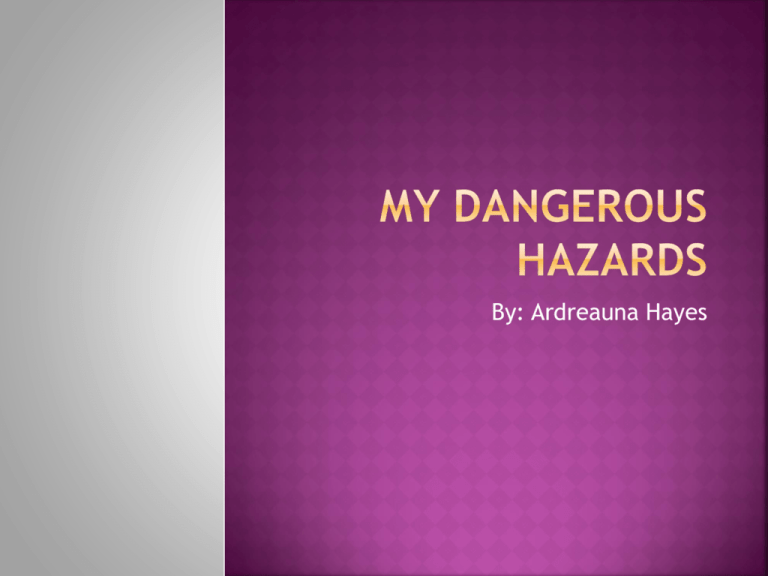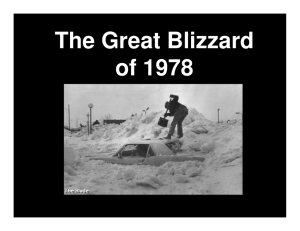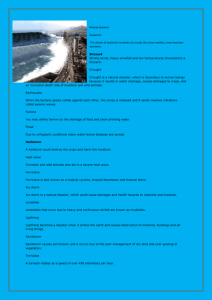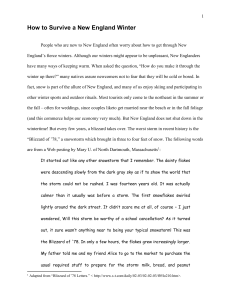My Dangerous Hazards
advertisement

By: Ardreauna Hayes Tornadoes aren’t the only danger, Tornado chasers have to be careful of the lightning coming from the thunderstorms that produces tornadoes. In 1983, lightning struck right next to five tornado chasers. Luckily they all lived. Hurricanes begin as tropical disturbances in warm ocean waters with surface temperatures of at least 80 degrees Fahrenheit (26.5 degrees Celsius). These low pressure systems are fed by energy from the warm seas. If a storm achieves wind speeds of 38 miles (61 kilometers) an hour, it becomes known as a tropical depression. A flood occurs when water overflows or inundates land that's normally dry. This can happen in a multitude of ways. Also there were $6 million in damage. A sandstorm is a strong dry wind blowing over the desert that raises and carries along clouds of sand or dust often so dense as to obscure the sun and reduce visibility almost to zero also known as a duststorm. A large eruption can be extremely dangerous for people living near a volcano. Flows of searing lava, which can reach 2,000 degrees Fahrenheit (1,250 degrees Celsius) or more, can be released, burning everything in its path, including whole towns. Boulders of hardening lava can rain down on villages. Mud flows from rapidly melting snow can strip mountains and valleys bare and bury towns Some 80 percent of all the planet's earthquakes occur along the rim of the Pacific Ocean, called the "Ring of Fire" because of the preponderance of volcanic activity there as well. Most earthquakes occur at fault zones, where tectonic plates—giant rock slabs that make up the Earth's upper layer—collide or slide against each other. These impacts are usually gradual and unnoticeable on the surface; however, immense stress can build up between plates. When this stress is released quickly, it sends massive vibrations, called seismic waves, often hundreds of miles through the rock and up to the surface. Other quakes can occur far from faults zones when plates are stretched or squeezed. A blizzard is a severe storm condition characterized by low temperatures, strong winds, and heavy snow. By definition, the difference between blizzard and a snowstorm is the strength of the wind. To be a blizzard, a snow storm must have winds in excess of 35 miles per hour .Additionally, blizzards must reduce visibility to 1/4 of a mile or less and must last for a prolonged period of time — typically three hours or more. Ground blizzards are a variation on the traditional blizzard, in that ground blizzards require high winds to stir up snow that has already fallen, rather than fresh snowfall. Regardless of the variety of blizzard, they can bring near-whiteout conditions, which restrict visibility to near zero. Blizzards have a negative impact on local economies and can paralyze regions for days at a time, particularly where snowfall is unusual or rare. If the storm is bad enough it can bury roads, cars and even houses if its strong enough. A thunderstorm is defined as a storm that contains lightening and thunder which is caused by unstable atmospheric conditions. When the upper air which is cold sinks and the warm moist air rises, storm clouds or ‘thunderheads’ develop resulting in thunderstorms. This can occur singularly, in clusters or in lines. Severe thunderstorms can bring in heavy rains which can cause flash floods, strong winds, lightening, hail and tornadoes. 1.In what year did the lighting struck during the tornadoes? A.2010 B.1983 C.1300 D.1823 2.What is the temperature of a hurricane when it starts? A.80 degrees B.100 degrees C.12 degrees D.46 degrees 3.When a flood occurs and ends how much money in damage will it be? A.$7 million B.$6 million C.$4 million D.$10 million 4.What is the other name for a sandstorm? A. Dustbowl B.Dustball C.Dustdog D.Dusty 5.How HOT is the volcano’s lava? A. 5.000 degrees B. 4,000 degrees C.2,000 degrees D. 3,000 degrees 6.What is the percent of the planet’s earthquakes? A.80% B.60% C.34% D.2% 7.How fast does the winds of a blizzard travel? A.40 miles per hour B.70 miles per hour C.35 miles per hour D.45 miles per hour 8. When the upper air which is cold sinks and the warm moist air rises, storm clouds is called what? A. Thunderhead B.Thundershower C.Thunderbed D.Thundermothership By: Ardreauna Hayes







